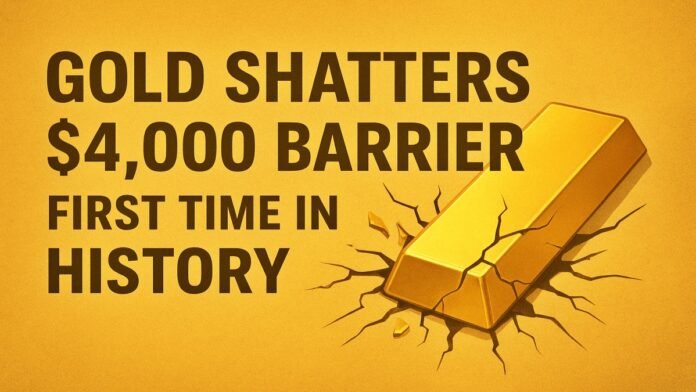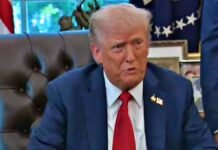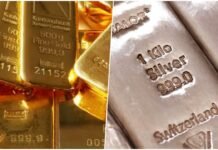
Key Points
- Gold breaks historic $4,000 per ounce milestone on Wednesday, October 8, 2025, reaching unprecedented high of $4,060.50
- December gold futures on COMEX hit $4,040 per ounce at 10 AM IST, marking first time in history this psychological barrier was breached
- Gold gains over 50% year-to-date, with 1.4% surge on Wednesday alone as investors seek safe-haven assets
- US government shutdown entering second week fuels uncertainty; delayed economic data releases add to investor anxiety
- Federal Reserve rate cut expectations drive rally as lower interest rates make gold more attractive versus bonds
- Goldman Sachs raises gold price target to $4,900 per ounce by end of 2026, up from previous $4,300 forecast
- Indian MCX December gold contract rises 0.87% to ₹1,22,170 per 10 grams; domestic retail prices hit ₹119,940 for 24-carat
- Silver also surges 1.44% to $48.20 per ounce on COMEX; Indian silver prices reach ₹1,47,354 per kg
- Central banks, especially China, diversifying away from US Treasuries into gold following sanctions on Russia
- Retail gold ETFs attract record $17.3 billion inflows in September driven by FOMO and geopolitical tensions
New Delhi: Gold prices achieved a historic milestone on Wednesday, October 8, 2025, surging past the psychologically significant $4,000 per ounce barrier for the first time in history, as mounting global economic and geopolitical uncertainties drove investors toward the ultimate safe-haven asset. This unprecedented achievement caps a remarkable year-long rally that has seen the precious metal gain over 50% since January, outperforming most major asset classes and establishing new benchmarks for precious metals markets worldwide.
Record-Breaking Price Action and Market Response
By 10:00 AM IST on Wednesday, spot gold had reached $4,060.50 per ounce, representing a robust 1.4% daily gain and extending the metal’s historic winning streak. December gold futures contracts on the COMEX exchange in New York simultaneously hit $4,040 per ounce, confirming the breakthrough above the critical $4,000 threshold that market analysts had been watching closely for months.
The surge represents the most significant gold price appreciation since the 1970s, when similar economic turbulence and currency devaluation concerns drove precious metals to then-record levels. Market veterans note that gold’s current rally exhibits stronger fundamentals than previous bull markets, with institutional demand from central banks and Exchange Traded Funds (ETFs) providing sustained buying pressure rather than speculative momentum alone.
Trading volumes have been exceptionally heavy, with Wednesday’s session recording $451.5 million in dollar volume, significantly above the average daily volume of recent months. This intense trading activity reflects broad-based participation from institutional investors, central banks, retail buyers, and algorithmic trading systems all responding to the historic price breakthrough.
US Government Shutdown Fuels Safe-Haven Demand
A primary catalyst for gold’s recent acceleration has been the ongoing US government shutdown, now entering its second week, which has created significant uncertainty about economic data releases and potential impacts on federal spending and economic growth. Analysts point to delays in critical economic data reporting due to the shutdown as a major factor increasing investor anxiety and driving demand for safe-haven assets.
Christopher Wong, a rates strategist at OCBC Bank in Singapore, characterized the government shutdown as a “tailwind for gold prices,” noting that historical precedent shows investors typically flock to precious metals during periods of political dysfunction in Washington. During President Trump’s first term, a month-long government shutdown resulted in gold prices climbing nearly 4%, establishing a pattern that current market participants are closely following.
The shutdown has raised concerns about potential mass federal layoffs and broader economic disruption, factors that traditionally boost demand for assets perceived as stores of value during periods of government instability. Additionally, uncertainty about when normal government operations will resume has created a risk-off sentiment across financial markets, benefiting gold at the expense of risk assets.
Federal Reserve Policy Expectations Drive Rally
Expectations of continued interest rate cuts by the US Federal Reserve represent another crucial driver of gold’s historic rally. Markets are currently pricing in two additional federal funds rate reductions by year-end, following the Fed’s decision to lower rates in September for the first time since 2023.
Lower interest rates make gold more attractive relative to yield-bearing assets like Treasury bills and certificates of deposit, as the opportunity cost of holding non-yielding precious metals diminishes. With the federal funds rate currently set between 4.00% and 4.25%, any further cuts would reduce the appeal of short-term debt instruments and potentially drive more capital toward gold.
Ray Dalio, founder of Bridgewater Associates, reinforced this investment thesis during remarks at the Greenwich Economic Forum in Connecticut, advising investors to allocate “approximately 15% of your portfolio to gold”. Dalio emphasized that debt securities are “not an effective store of wealth” in the current environment and highlighted gold as “the one asset that performs well when the usual components of your portfolio decline”.
Goldman Sachs Raises Price Targets Amid Structural Demand
Goldman Sachs, one of the world’s most influential investment banks, updated its gold price forecasts on Monday, raising the 2026 target to $4,900 per ounce from a previous estimate of $4,300. This significant upward revision reflects the bank’s assessment that structural factors driving gold demand will persist well beyond current market volatility.
Goldman strategists noted that “the flows driving the rally since 2026—Western ETF inflows and likely central bank purchases—are consistent in our pricing model, effectively elevating the baseline of our price forecast”. The bank anticipates that demand from central banks, particularly in emerging markets, along with Western ETF buyers, will remain pivotal throughout next year.
Independent metals trader Tai Wong expressed even more bullish sentiment, stating: “There’s considerable confidence in this trade right now, and the market will likely target the next significant milestone, which is $5,000, especially with the Fed expected to keep lowering rates”. Wong added that while some obstacles could emerge, “the core factors driving this trade—massive and increasing debt, reserve diversification, and a weakening dollar—are unlikely to shift in the near future”.
Indian Markets Reflect Global Surge
Indian precious metals markets have closely tracked international price movements, with significant gains recorded across domestic trading platforms. The December 5, 2025, gold contract on India’s Multi Commodity Exchange (MCX) rose 0.87% to ₹1,22,170 per 10 grams, while the corresponding silver contract gained 1.07% to reach ₹1,47,354 per kilogram.
Retail gold prices in India have responded accordingly, with the Indian Bullion Jewellers Association reporting that 24-carat gold is trading at ₹119,940 per 10 grams, while 22-carat gold is priced at ₹117,060 per 10 grams. Silver retail prices have reached ₹149,441 per kilogram, reflecting the global surge in precious metals.
Maneesh Sharma, Assistant Vice President for Commodities & Currencies at Anand Rathi Shares and Stock Brokers, noted that gold prices are likely to continue rising ahead of Diwali, as the Indian festive season typically generates strong retail demand for precious metals. Indian dealers are currently quoting premiums of $8-10 per ounce over official domestic prices, including 6% import and 3% sales levies, indicating robust physical demand.
Trade and government sources revealed that India’s imports of gold and silver nearly doubled in September from August levels, defying record high prices as banks and jewellers rushed to build inventories ahead of festivals and escape potential higher import taxes. This strong buying from India, the world’s second-largest gold consumer, has helped offset slower demand from China and provided additional support for global prices.
Silver Markets Join the Rally
Silver has participated strongly in the precious metals rally, with COMEX silver futures gaining 1.44% to reach $48.20 per ounce on Wednesday. The white metal has achieved even more impressive year-to-date returns than gold, posting gains of nearly 70% since January 1, 2025 [original article]. This outperformance reflects silver’s dual nature as both a precious metal and an industrial commodity, benefiting from safe-haven demand as well as supply constraints in industrial applications.
The gold-to-silver ratio, a key metric watched by precious metals traders, has declined significantly during the current rally, indicating that silver is outperforming gold on a relative basis. This pattern often occurs during the latter stages of precious metals bull markets, when industrial demand for silver combines with investment demand to drive prices higher.
Silver’s strong performance has been supported by growing demand from solar panel manufacturing, electronics production, and other industrial applications, even as investment demand has surged alongside gold. The combination of these factors has created a supply-demand imbalance that is contributing to price appreciation.
Central Bank Buying and Reserve Diversification
A structural shift in central bank behavior has provided fundamental support for gold’s historic rally. Nations including China have been diversifying their foreign exchange reserves away from US Treasury securities toward gold, a trend accelerated by geopolitical tensions and concerns about potential sanctions.
This reserve diversification gained momentum following stringent sanctions imposed by Washington on Russia after its 2022 invasion of Ukraine, which demonstrated how dollar-denominated assets could be frozen or confiscated during international disputes. As a result, many emerging market central banks have increased their gold purchases as a hedge against potential financial sanctions and to reduce dependence on the US financial system.
Central bank gold purchases have provided a steady bid under the market, creating a floor for prices even during periods of reduced retail investor interest. This institutional demand represents a significant change from previous decades when central banks were often net sellers of gold reserves.
Retail Investment Surge and FOMO Effect
Retail investors have joined the gold rally in unprecedented numbers, with Exchange Traded Funds focused on precious metals attracting massive inflows. Gold ETFs recorded an astounding $17.3 billion in net inflows during September alone, driven by political tensions, options market activity, and a weakening US dollar.
This surge in retail participation has been characterized by some analysts as a “fear of missing out” (FOMO) phenomenon, where investors anxious about potentially missing one of the year’s best-performing assets have rushed to establish positions. The exceptional demand has been partially fueled by what experts refer to as the “debasement trade,” involving retail investors purchasing gold as protection against escalating federal debt and threats to the Federal Reserve’s independence.
Online precious metals dealers and coin shops have reported surging demand for physical gold and silver, with many products commanding significant premiums over spot prices due to supply constraints. This physical demand has provided additional support for paper gold markets and reinforced the upward price momentum.
Technical Analysis and Price Outlook
From a technical perspective, gold’s breakthrough above $4,000 represents a significant psychological and resistance level that had been closely watched by traders and analysts. Weekly momentum indicators continue to show room for further price advances, though daily Relative Strength Index (RSI) readings above 80 indicate overbought conditions that could lead to short-term consolidation.
Market technicians note that gold has been “up seven consecutive weeks in a row,” a pattern that historically has preceded short-term weakness, as evidenced during similar periods in 1979. Additionally, gold currently trades approximately 21-23% above its 200-day moving average and 70-75% above its 200-week moving average, suggesting that a temporary correction or consolidation could occur in the coming weeks.
However, technical analysts emphasize that any pullbacks should be viewed as buying opportunities, as the current yearly advance remains smaller than the historic bull markets of the 1970s and 2000s, suggesting further upside potential over the next several quarters. Key support levels to watch include the 20-day moving average around $3,715 and the 50-day moving average near $3,515.
Multiple Geopolitical Risk Factors
Beyond US domestic political issues, multiple international conflicts and tensions have contributed to safe-haven demand for gold. The ongoing wars in Ukraine and Gaza have pushed many investors to seek security in precious metals, while economic concerns in major economies including Japan and Argentina have added to global uncertainty.
Political turmoil in France, one of Europe’s largest economies, has also contributed to risk-off sentiment in global markets [original article]. Additionally, escalating tensions between major powers and uncertainty about trade policies have created an environment where investors prize the stability and universal acceptance of gold.
These geopolitical factors have created what analysts describe as a “perfect storm” for gold demand, with multiple risk factors occurring simultaneously rather than the single-issue crises that have driven previous precious metals rallies. This broad-based uncertainty has attracted diverse investor groups, from individual retail buyers to sovereign wealth funds and pension systems.
Currency Debasement Concerns
The US dollar has declined approximately 10% year-to-date, creating an additional tailwind for gold prices. This dollar weakness has made gold more affordable for international buyers while simultaneously raising concerns about currency debasement that drive domestic US investors toward precious metals.
With current inflation running at 2.9%, above the Federal Reserve’s 2% target, investors remain anxious that persistent price pressures could erode the dollar’s purchasing power over time. This inflation dynamic, combined with massive federal debt levels and ongoing deficit spending, has reinforced the appeal of gold as a store of value that maintains purchasing power across different economic environments.
President Donald Trump’s repeated criticism of the Federal Reserve and calls for faster rate cuts have also raised concerns about central bank independence, another factor that has traditionally supported gold demand. These political pressures on monetary policy have added to investor uncertainty about the long-term stability of the dollar and traditional financial assets.
Market Warnings and Risk Factors
Despite the euphoric sentiment surrounding gold’s historic breakthrough, some market observers have issued cautionary notes about potential risks ahead. Bank of America warned investors on Monday to proceed carefully as prices approached the $4,000 mark, alerting clients to potential “uptrend exhaustion” that could result in a “consolidation correction”.
Potential obstacles to continued gold appreciation could include a lasting peace agreement in the Middle East or Ukraine, which would reduce geopolitical risk premiums, or unexpected economic strength that reduces demand for safe-haven assets. Additionally, if the US government shutdown is resolved quickly and economic data shows continued resilience, some of the current uncertainty premium could be removed from gold prices.
However, most analysts emphasize that the fundamental drivers of gold demand—including massive government debt levels, reserve diversification by central banks, and persistent inflation concerns—are structural factors unlikely to change in the near term. This suggests that while short-term volatility is possible, the longer-term outlook for gold remains positive.
Global Economic Implications
Gold’s historic rally reflects broader concerns about the stability of the global financial system and traditional stores of value. The unprecedented price levels being achieved suggest that investors are increasingly questioning the sustainability of current debt levels, monetary policies, and geopolitical arrangements that have underpinned financial markets for decades.
For central banks and government treasuries worldwide, rising gold prices represent both an opportunity and a challenge. Countries with significant gold reserves benefit from the increased value of their holdings, while those dependent on dollar-denominated assets face questions about long-term portfolio allocation strategies.
The precious metals rally also has implications for industries that use gold and silver as inputs, potentially increasing costs for jewelry manufacturers, electronics producers, and other sectors that rely on these materials. However, mining companies and precious metals producers are benefiting significantly from the higher prices, with many mining stocks outperforming broader market indices.
As gold continues its historic ascent past $4,000 per ounce, the precious metals markets are writing a new chapter in financial history, one that reflects deep-seated concerns about traditional assets and growing appreciation for tangible stores of value in an increasingly uncertain world. Whether this rally continues toward the $5,000 target that some analysts envision, or experiences the consolidation that technical indicators suggest, the breakthrough above $4,000 represents a watershed moment that will be remembered as a defining achievement in the annals of precious metals trading.












































